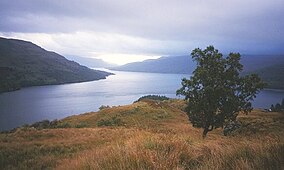
Back Loch Lomond a The Trossachs Czech Loch Lomond and the Trossachs National Park Danish Loch-Lomond-and-the-Trossachs-Nationalpark German Parque nacional Lago Lomond y los Trossachs Spanish Loch Lomond eta The Trossachs Parke Nazionala Basque Loch Lomondin ja Trossachsin kansallispuisto Finnish Parc national du Loch Lomond et des Trossachs French Pàirc Nàiseanta Loch Laomainn agus nan Tròisichean Irish Pàirc Nàiseanta Loch Laomainn agus nan Tròisichean Scots/Gaelic Loch Lomond dan Taman Nasional Trossachs ID
| Loch Lomond and The Trossachs National Park | |
|---|---|
IUCN category V (protected landscape/seascape) | |
 Looking eastwards along Loch Katrine | |
 | |
| Location | United Kingdom (Scotland) |
| Coordinates | 56°15′N 4°37′W / 56.250°N 4.617°W |
| Area | 1,865 km2 (720 sq mi)[1] |
| Established | 2002 |
| Governing body | National park authority |
| Website | Official Website |
| UK National Parks |
|---|
| Parentheses denotes the year. An area with ‡ has similar status to a UK National Park. Areas marked † are proposed. |
Loch Lomond and The Trossachs National Park (Scottish Gaelic: Pàirc Nàiseanta Loch Laomainn is nan Tròisichean) is a national park in Scotland centred on Loch Lomond and the hills and glens of the Trossachs, along with several other ranges of hills. It was the first of the two national parks established by the Scottish Parliament in 2002,[2] the second being the Cairngorms National Park. The park extends to cover much of the western part of the southern highlands, lying to the north of the Glasgow conurbation, and contains many mountains and lochs. It is the fourth-largest national park in the British Isles, with a total area of 1,865 km2 (720 sq mi) and a boundary of some 350 km (220 mi) in length. It features 21 Munros (including Ben Lomond, Ben Lui, Beinn Challuim, Ben More and two peaks called Ben Vorlich) and 20 Corbetts.
The park straddles the Highland Boundary Fault, which divides it into two distinct regions - lowland and highland - that differ in underlying geology, soil types and topography.[3] The change in rock type can most clearly be seen at Loch Lomond itself, as the fault runs across the islands of Inchmurrin, Creinch, Torrinch and Inchcailloch and over the ridge of Conic Hill. To the south lie green fields and cultivated land; to the north, mountains.[4]
The Loch Lomond and The Trossachs National Park lies close to Scotland's heavily populated Central Belt, and the area has long been popular with visitors. Principal attractions are viewing scenery and wildlife, walking, climbing, water sports, and other outdoor activities.[5] In 2017, there were 2.9 million visits to the park, of which 2.1 million were day visits and 783,000 were made by visitors staying overnight within the park.[6]
- ^ "Key Facts". Loch Lomond and The Trossachs National Park Authority. Retrieved 16 April 2019.
- ^ "National park 'goes live'". BBC News. 8 July 2002.
- ^ Wild Park 2020. p. 55.
- ^ Tom Weir (1980). The Scottish Lochs. Constable and Company. pp. 33–43. ISBN 0-09-463270-7.
- ^ "Archived copy" (PDF). Archived from the original (PDF) on 14 June 2019. Retrieved 29 January 2017.
{{cite web}}: CS1 maint: archived copy as title (link) - ^ Cite error: The named reference
visitorswas invoked but never defined (see the help page).